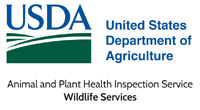United States Department of Agriculture: Animal and Plant Health Inspection Service

United States Department of Agriculture Wildlife Services: Staff Publications
ORCID IDs
0000-0003-0765-7198
Document Type
Article
Date of this Version
2018
Citation
Journal of Mammalogy, 99(6):1405–1410, 2018
Abstract
Mexican wolves (Canis lupus baileyi) share their range with a number of sympatric carnivores, many of which are a concern to livestock producers because they can prey on livestock. Determining which predator species is responsible for killing livestock is important for determining appropriate management actions and for the conservation of Mexican wolves. A variety of information can be used to decipher which carnivore species was responsible for making a kill, and mandibular (upper) and maxillary (lower) intercanine width measurements (i.e., bite mark analysis) can aid this process. No research has been conducted to validate the usefulness of bite mark analysis; thus, we used dentition measurements from Mexican wolves, coyotes (Canis latrans), feral dogs (Canis familiaris), bobcats (Lynx rufus), mountain lions (Puma concolor), and gray foxes (Urocyon cinereoargenteus) and an overlap coefficient to evaluate the degree of overlap in intercanine width between these species. We found that larger carnivore species had greater overlap than smaller carnivores, feral dogs overlapped widely with all the medium-to-large carnivores, and upper and lower intercanine width measurements provided similar information. Our data indicated that when investigating livestock depredations for Mexican wolves, bite mark analyses should be evaluated along with additional forensic evidence due to the overlap between many of the carnivore species, and that measurements between 28 and 35 mm have the greatest uncertainty because this range overlaps with feral dogs, mountain lions, and coyotes.


Comments
This work is written by (a) US Government employee(s) and is in the public domain in the US.
DOI:10.1093/jmammal/gyy145